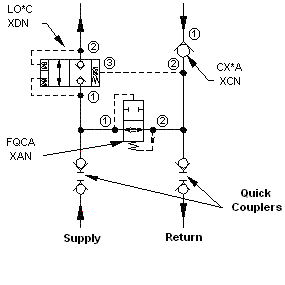The Quick Coupler Circuit

This circuit is an interesting solution to a problem. The problem stems from connecting an accessory circuit to a main circuit with quick-couplers. The accessory circuit could be a backhoe attachment for a skid steer loader or a kidney loop filter system or any sub-system that is sensitive to back pressure. My personal experience was with a backhoe attachment that used a stack type directional valve. If the tank pressure went too high the tie-bolts on the directional valve would break.
Out of all the ways there are to hook up an accessory circuit with quick-couplers, two could be destructive. Those two are; connecting them up backwards (which could be prevented by cross sexing the couplers) or connecting the supply without connecting the return. Both of these pressurize the entire sub-system, breaking bolts or housings and blowing off filter cans. The Quick-coupler circuit solves both problems.
How it works
If the couplers are connected correctly………there is a path for the fluid coming out of the FQCA and it trips (closes). The LO_C opens all the way.
If the couplers are not connected correctly……. the FQCA is a normally open valve, the area between the CX_A and the unconnected quick-coupler becomes pressurized and prevents the LO_C from opening. The FQCA stays open because there is no flow through it. In other words, because there is no path for the oil to get out of the accessory circuit, no oil is allowed in.
How to apply it
The LO_C XDN and the CX_A XCN have to be sized to handle the flow of your accessory circuit. The setting of the FQCA XAN should not be critical, .25 gpm (1 L/m) should suffice.
Circuit courtesy of Jim Kaas - Iowa Fluid Power

